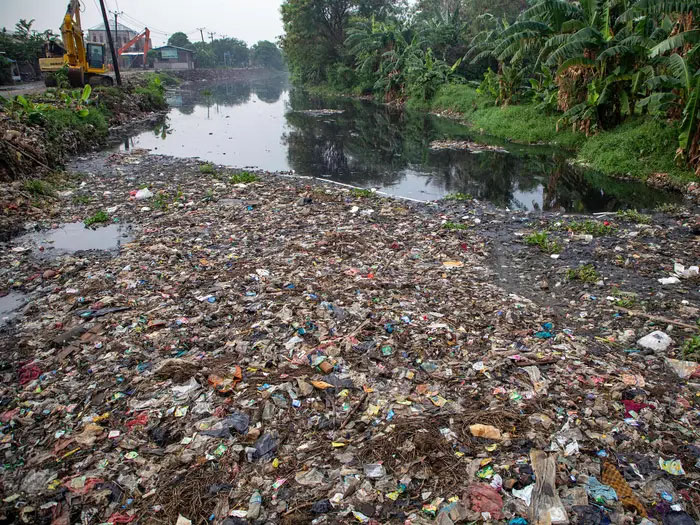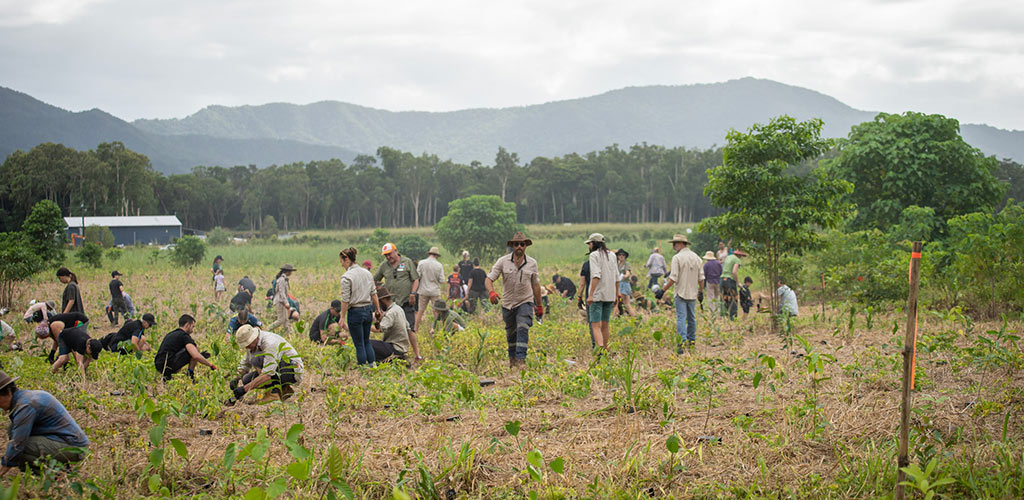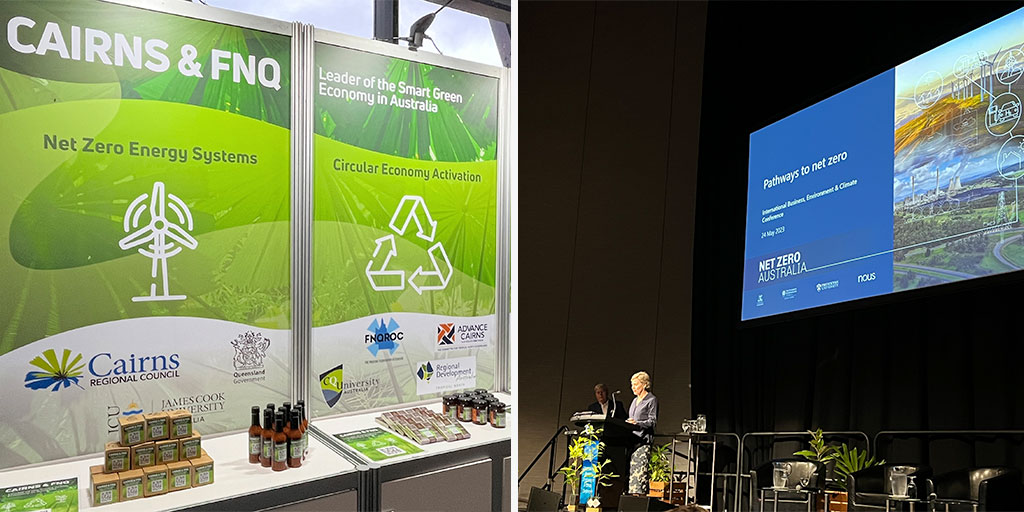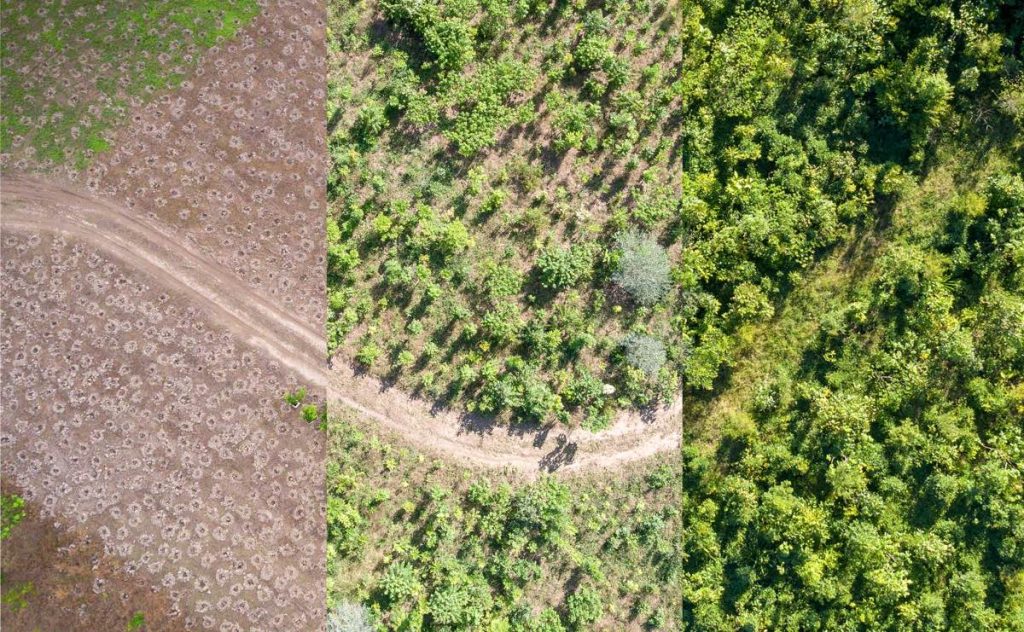From Rubbish to Rainforests – Reflecting on World Environment Day 2023
At Rainforest Rescue we’re big fans of a day that brings an environmental cause to the fore. Dates in the calendar like World Environment Day act as reminders of the importance of stepping out of our own busy lives to consider something bigger, something we have the potential to contribute towards.
If we choose to.

Pisang Batu River in Indonesia choked with plastic pollution. Image credit: Donal Husni/NurPhoto via Getty Images
This year’s theme for World Environment Day is ‘finding solutions to plastic pollution’, with the hashtag #BeatPlasticPollution.
To be frank, it’s going to take more than a day to solve this problem.
Our reliance on plastic is, at times, astounding.
While the material may have revolutionised our consumer lives, it’s excelled itself as an absolute blight on our planet. Plastics turn river systems into pollutant sources, single-use plastics choke marine species to death and micro-plastics are piling up in our soil systems and the living bodies of animals around the world–including us: humans. Fossil fuels are used to produce plastic, which contributes to greenhouse gas emissions and in turn does its bit for exacerbating climate change. Yay, plastic!
But wait. We’re rescuing and restoring rainforests. What’s the relevance of plastic to that?
Let’s connect some dots.

Tree planters at the Rainforest Rescue Annual Community Tree Planting Day at Nightwings Rainforest Centre, Lower Daintree.
Local-level impact
Earlier in May the biggest ever Rainforest Rescue Annual Community Tree Planting Day took place. (You can read more about how successful the event was in our Recap article)
As a point in the calendar for the collective good to heal country, it was right up there. Thousands of trees were planted. Many people, partners and organisations came together for a common cause. A positive, long-term impact is underway.
This is immediate, on-ground, hands-on work. We can see the habitat around us that the newly planted trees will join and grow up with. Lowland tropical rainforest can return to what was a former agricultural site, which was lowland tropical rainforest before that. For millions of years.
A couple of weeks later Rainforest Rescue is out and about in the regional community, as one of many organisations involved with the Douglas Shire Sustainability Story.
Douglas Shire Council was the first local council to adopt a sustainable tourism strategy in 1998. And then in 2019, the region was awarded Australia’s first Ecotourism Australia ECO Destination certification. The Sustainability Story places a future lens on the region where the majority of Rainforest Rescue’s team lives, works and contributes to protecting and regenerating rainforest habitat up here in Far North Queensland.
At the event we share stories with local business owners and operators, several of whom live amongst the rainforest that we’re so closely associated with. For some, their livelihood depends on an ecosystem that many travel thousands of kilometres for a first-hand encounter. We’re experiencing the intact rainforest and adjacent habitats evolving into a viable economy.
During the Sustainability Story there is an acknowledgement of the connectivity between tourism and the environment, of a desire to ‘give back’ to a place that thousands of people visit every year.
Many tourists want to feel like they can make a positive impact in the area they travel in. Their journey has so many opportunities for sustainable interaction and local outcomes.
Crag Carttling, Tourism Facilitator, Jabalbina Aboriginal Corporation
You can’t help notice a common sensitivity in how this region in Far North Queensland is considering its future. Can sustainability in the Douglas Shire successfully balance economic value, cultural connection and positive environmental impact? The sentiment is optimistic but we all know there’s a way to go.
An event like this is also where we see how the rainforest and our work interlocks to elsewhere. The river systems and mangroves, the tableland savannah and eucalypt woodlands and the reef offshore are supported by organisations similar to ours, made of teams working hard to ensure these ecosystems remain healthy and restoration can take place where human impact has done damage. Focal points like the Mossman Botanic Garden place natural habitats into context for tourists and communities.
Collectively, these organisations and Rainforest Rescue are examples of restorative action. Thankfully, we also have other local organisations like Plastic Free Cairns and Circular Economy Cairns. They’re tackling the other side of a complex equation that is working towards the sustainable, lower-impact future of humanity–In stark contrast to our current insatiable resource intake, production and consumption by humans that our planet is struggling to keep up with.

Organisations raising the profile of the Circular Economy and Net Zero in Australia, IBECC 2023.
International-scale climate anxiety
In the same week the International Business, Environment and Climate Conference in Cairns highlighted to delegates the challenge of Australia reaching Net Zero in carbon emissions by 2050.
We witnessed lofty, multi-faceted, cross-industry thinking and doing which caused a ripple of concern with the organisations present. What about the fossil fuel industry? Who’ll tell the farmers? Aren’t there countries who’ll do less than the rest? Haven’t we been here before?
We have and we will be again.
But it’s by working up through the strata of these events, from grass-roots to conference centre stage and beyond that we observe the collective concern.
We have really, really made a hash of things on this planet as a species.
Fortunately, we might have the collective intelligence to realise this and push back.

The outcomes of reforestation over a 3 year period, on-ground proof of positive environmental action.
The future of positive environmental action
We zero back in again on our Community Tree Planting Day and the horizon of trees ready to go into the ground. Our plants are snug in their pots which are arranged neatly in trays. Thousands upon thousands of pots and trays.
All made of plastic.
It’s something we’re acutely aware of. Every pot and its respective tray is washed, sterilised and used again and again after the trees are planted. We have saved tons of plastic from going into landfill by our effort to ensure this reuse process in our work remains in place.
Someday soon we’ll move from plastic to a lower impact container. Perhaps it is made from a material that has not been invented yet, which the move to a restoration economy will necessitate and an entrepreneurial mind will uncover.
Carbon removal locally is a high value, close impact process. You can see the difference.
Daniel Walsh, Founder, Reforest
In the future we could envisage that the rainforest itself contributes towards the economy and its ecosystem health is a measure of the value of an economy. We know this because organisations like Intrinsic Exchange now exist. Web3 and the blockchain could yield ways for organisations like Rainforest Rescue to connect globally to drive outcomes. The team at Reforest are placing environmental change and impact in the palm of our hands – so that we have the ability to be climate positive in the tiniest of our actions.
Which brings us full circle to World Environment Day 2023.
Now we realise this isn’t just a notable day in the calendar for raising awareness of environmental impact, that plastics and the rainforest, beyond a convenient way to store young trees, do have something in common:
Driving change.
Today is one of many days, hundreds and thousands of them, cast out in front of us like a string of pearls. And each one brings us closer to an uncertain future. Although, it’s a future that we can architect through change.
Might we reach Net Zero by 2050 and envisage living in a future almost devoid of plastic? By deciding to make fundamental changes to consumption and by investing in scaled economies that restore and regenerate, there is a chance we will witness the point of intersection in the decline of plastic consumption and the regrowth of ancient, natural habitat. The parts of an equation that results in a decrease in CO2 reduction due to lowering emissions and increasing the ability to process and store carbon through more trees.
It’s a huge, overwhelming step in a different direction for us all. Profound change isn’t easy.
The one thing we can control to a reasonable degree though, is our individual actions. Our attitudes, behaviours and habits are there for us to change.
We all know what we need to do.
Thank you for being a part of Rainforest Rescue, and thank you for doing what you can do to help our environment.
It’s our Nature to protect.
Want more good Rainforest news in your life?
Subscribe to our eNews | Follow us on Instagram | Like us on Facebook | Subscribe to our YouTube channel
Help Protect Rainforests Forever
Donate to Protect Rainforests Forever | Become a Rainforest Guardian | Partnership Options

